Dachshunds have quite the reputation for being clever 🧠, bold 💪, and a little stubborn 😅, especially when it comes to training. If you’ve ever tried to train a Doxie, you’ve probably noticed how they sometimes just ignore commands or only listen when it suits them 🙃.
The trick to training a stubborn Dachshund? Use strategies that fit their personality 🎯 and keep things positive 🌟.
It’s honestly pretty normal to get frustrated when your Dachshund seems to do their own thing 😤. But with patience and the right approach 🐾, you can shape their behavior without getting harsh.
Let’s dig into what actually works with these unique little dogs 🐶.
Key Takeaways ✅
- Understanding your Dachshund’s stubbornness leads to better training results 🐕
- Using positive reinforcement helps your Doxie learn new behaviors 🍖
- Consistency and patience are important for long-term success ⏳
🐾 Free Dachshund Care Guide
Download our free checklist to ensure your Dachshund stays happy, healthy, and well-loved!
Get Your Free Guide 🐶Understanding Dachshund Stubbornness
Dachshund stubbornness goes way back to their roots as hunters 🐾. Their specific heritage and personality quirks can lead to some unique challenges 🎯.
Genetic Origins of Stubborn Behavior 🧬
People in Germany bred Dachshunds to hunt badgers and small animals 🦡. These dogs had to work alone, make quick decisions, and stay focused even when humans weren’t around 🐕.
Key traits influenced by genetics include:
- Strong sense of smell 👃
- High self-confidence 💥
- Independence 🧍
Because of these instincts, Dachshunds might ignore you if something else catches their attention 🐿️. Their determination to figure things out on their own can look a lot like defiance 😤.
Selective breeding over time made these qualities even stronger 💪. Unlike some breeds that just want to please, Dachshunds often weigh their options before they respond 🧠.
If your Dachshund seems slow to follow instructions or wants to do things their own way, it’s usually those inherited traits at play 🧬.

🥗 Wild Earth Dog Food – Clean Protein for Healthier Doxies
Powered by plant-based ingredients, this veterinarian-developed dog food supports healthy digestion, weight, and energy in Dachshunds.
- ✅ 100% plant-based and cruelty-free
- ✅ Great for sensitive stomachs and allergies
- ✅ High in clean protein to support active pups
How Stubbornness Manifests in Doxies 🐶
You’ll see Dachshund stubbornness in everyday situations 🚶. Maybe your dog won’t come when called or gets stuck on a scent even if you try to distract them 🔍.

Common signs of stubbornness include:
- Ignoring recall commands 🚫
- Barking at small animals 🐇
- Digging even after being told no 🕳️
- Refusing to walk or pulling in the opposite direction 🐾
Honestly, you’ll need some extra patience ⏳. Repeating commands can just make some Dachshunds more stubborn 😅. Treats or praise usually help, but sometimes your dog just won’t budge 🎁.
If your Doxie seems tough to train, it’s not because they aren’t smart 🧠. Their stubbornness is really about strong will and independence, not a lack of understanding.
Misconceptions About Dachshund Temperament 🧐
Some folks think Dachshunds are just disobedient or always causing trouble 😈. That’s not really fair. Their stubbornness is often misunderstood and gets confused with bad behavior ❌.
It’s important to tell the difference between stubbornness and real aggression or disobedience ⚠️. Dachshunds are usually loyal and loving, but their instincts sometimes overpower basic obedience ❤️.
Myths and Facts Table 📋
| Myth | Fact |
|---|---|
| Dachshunds are mean | Most are friendly and enjoy people 😊 |
| They can’t be trained | Dachshunds respond with the right approach 🐾 |
| Stubbornness is spite | It’s usually independence, not revenge 💭 |
If you get where they’re coming from, you can adjust your training approach and enjoy a better relationship with your dog 🐕🦺
Common Challenges in Training a Stubborn Doxie
Dachshunds are smart and alert 🧠, but their stubborn streak can make training a real challenge 😅. If you know about their distractibility and resistance to commands, you can pick better solutions 🎯.
Distraction and Independence 🐿️
Dachshunds were bred to hunt on their own, so they often follow their own interests 🐾. That independence means they get distracted easily during training 🚶♂️.
A Doxie might lose focus if a bird flies by, another dog barks, or there’s a new smell in the yard 👃.
Common distractions for Dachshunds include:
- Moving objects (toys, small animals) 🧸
- New sounds or scents 🔊
- Other pets or people nearby 🐕
You can help your Doxie focus by training in a quiet spot with few distractions 🌳. Keep sessions short—just 5 to 10 minutes ⏱️. If your dog wanders off, call them back with treats or a gentle, firm voice 🍖. It really does take consistency and a lot of patience 💛.
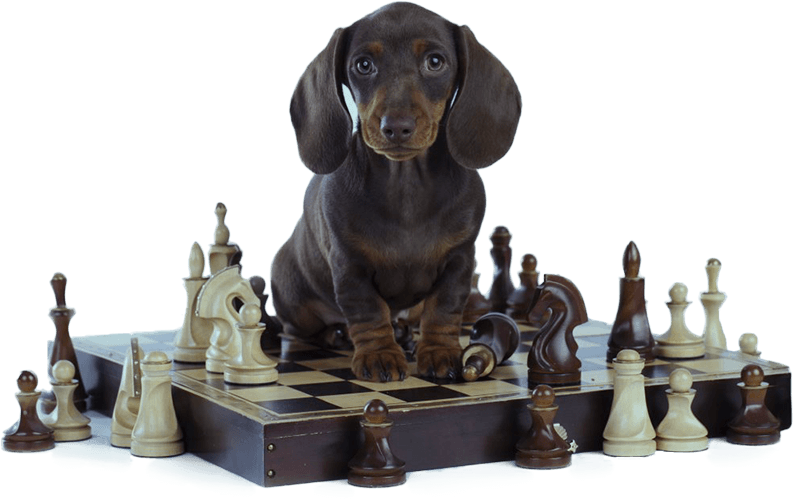
🧠 Brain Training for Dogs – Smart Solutions for Stubborn Dachshunds
This digital program turns obedience into a fun game, helping your Dachshund stay focused while learning new tricks and routines at home.
- ✅ Designed to reduce stubborn and disobedient behavior
- ✅ Builds focus, impulse control, and confidence
- ✅ Great for bored or easily distracted dogs

Resistance to Commands 🛑
Dachshunds sometimes know exactly what you want but still decide not to listen 🙃. You’ll see it when they ignore a command, walk away, or suddenly get interested in something else 🐾.
Typical signs of resistance:
- Refusing to sit or stay on cue 🚫
- Turning away when called 🔄
- Stopping in the middle of learning a new trick 🌀
Strong-willed dogs need rewards and praise, not harsh corrections 🌟. If you get too tough, your dog might just shut down or get anxious 😟.
Keep your commands simple and use the same words every time 🗣️. Try to end sessions on a good note, even if progress is slow ✨. Some days, that’s just how it goes.
Effective Training Strategies That Work

Training a stubborn Doxie means building trust 🤝 and making daily habits stick 📅. Focus on a routine, and handle challenges with patience—even when it’s tough 😌.
Building Trust With Your Dachshund 🐶
Trust matters a lot when you’re training a stubborn Dachshund 💛. Show your dog you’re calm, fair, and not going to lose your cool 😇.
Don’t yell or punish your Doxie 🚫. That usually just makes them anxious or even more stubborn 😣.
Go with positive reinforcement ✅. Give treats, gentle praise, or a favorite toy every time your Dachshund listens 🎾. Short, upbeat sessions work best 🎉. Try 5–10 minutes, a couple times a day, so your dog doesn’t get bored or distracted 🐾.
Let your dog take breaks if they seem tired 💤. Be patient—building trust can take a while ⏳. But once your Doxie feels safe, they’re much more likely to listen and learn 🐕.
Do’s and Don’ts 📋
| Do’s | Don’ts |
|---|---|
| Use treats and praise 🍖 | Shout or use harsh punishments ❗ |
| Keep sessions short ⏱️ | Force your dog to obey 🚫 |
| Respect your dog’s pace 🐾 | Ignore signs of stress ⚠️ |

👨🍳 ChefPaw Fresh Food Maker
- ✅ Make healthy meals at home with ease
- ✅ Perfect for dogs with food sensitivities
- ✅ Say goodbye to preservatives and fillers

🍽️ Petlibro Automatic Feeder
- ✅ Keeps mealtimes consistent—even when you’re busy
- ✅ Helps avoid overfeeding or missed meals
- ✅ Great for pups with sensitive routines

Consistency and Patience in Daily Routine 🕒
Consistency really helps both you and your Doxie 🤎. Stick with the same commands every time 🔁. Make sure family members use the same words so your dog doesn’t get mixed signals 🗣️.
Set routines for feeding, walks, and bathroom breaks 🦴. Your Doxie will know what to expect. Try to keep the schedule steady—even small changes can throw a stubborn dog off ⏰.
If your Doxie ignores a command, stay calm and repeat it once or twice 😌. Don’t give up too soon or start trying new commands. Praise good behavior right away, but don’t reward stubbornness 🎯.
Here’s a simple checklist:
- Stick to one word per command: (Example: “Sit” instead of “Sit down now”) 🐾
- Reward right after the behavior 🍪
- Practice at the same time daily 📆
Stay steady and patient 💪. Over time, your Dachshund will get more confident and start to understand what you want. Training a stubborn Doxie really does get easier with practice 🌟.
Positive Reinforcement Dachshund Techniques

Dachshunds really do best when you reward good behavior 🎉. Positive reinforcement helps them learn faster and makes training a whole lot less stressful for both of you 🧘.
Reward-Based Training Methods 🍖
Positive reinforcement training means you give a reward right after your dog does what you want 🎯. That might be a treat, a favorite toy, or just some extra playtime 🎾. The important part is to offer the reward right away so your dachshund connects the dots 🧠.
Use a clear, consistent command 🗣️. If your dachshund sits, say “Good sit!” and hand over the treat. Timing is everything—if you wait too long, your dog might not get why they’re being rewarded ⏱️.
Keep training sessions short (5–10 minutes tops) 📏. Dachshunds lose focus quickly, so lots of breaks help keep them interested 🐶.
Common reward-based methods include:
- Clicker training: Click when your dog does the right thing, then give a treat 🎯
- Shaping: Reward small steps toward the behavior you want 🪜
- Luring: Use a treat to guide your dog into the right position 🪄
Stick with it and be patient 🙌. Your dachshund will get there—it just takes a little time and a lot of treats 🥓.

🧫 AnimalBiome Gut Health Test Kit
- ✅ Identify gut imbalances that may influence mood or stubborn behavior 🧠
- ✅ Supports better focus and responsiveness during training 🎯
- ✅ Easy home test with actionable results for long-term well-being 🌿

🧘♀️ Zumalka Calmpet Anxiety Relief Drops
- ✅ Naturally eases anxiety that fuels resistance during training 🐾
- ✅ Promotes calm focus so your Dachshund listens and learns faster 💡
- ✅ Safe, gentle, and effective for daily behavioral balance 🌸
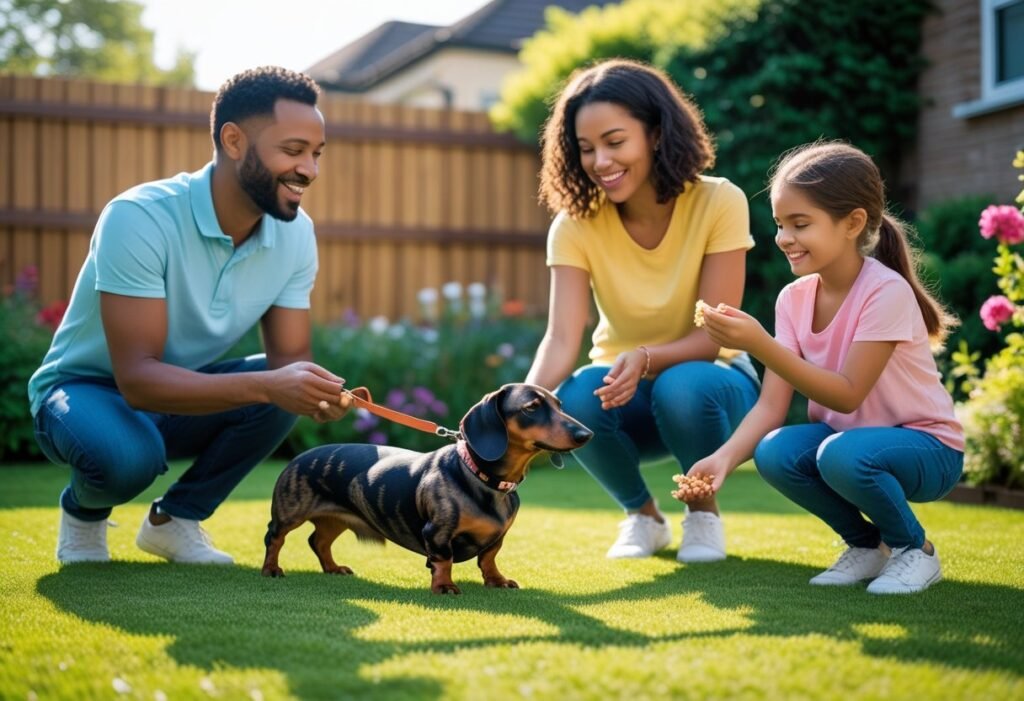
How to Use Treats and Praise Effectively 🗝️
Treats work best when they’re small, soft, and a bit special 🍬. Choose treats your dachshund doesn’t get at other times 🌟.
Tiny pieces of cooked chicken or store-bought training treats usually do the trick 🥓. Watch out for overdoing it—too many treats can pack on pounds, so you might want to cut back their meal portions if needed ⚖️.
Praise should be clear and upbeat, not forced or over the top 🥰. Try using a happy voice and say “Good dog!” right as your dachshund does what you asked 🎵.
If you praise all the time, it starts to lose meaning 🛑. Mixing treats and praise together seems to encourage dachshunds to repeat the actions you want 🔁.
Tips for effective use:
- Switch between treats and praise to keep things interesting 🧩
- Slowly reduce treats as your dachshund gets the hang of each behavior 📉
- Skip treats that take ages to chew—they’ll slow down your training sessions 🕰️
Avoiding Common Training Mistakes

Training a dachshund can feel tricky if you don’t use clear communication and patience 🧘. Small missteps can quickly cause confusion or stubbornness 😖.
Inconsistency in Commands 🔄
Using different words or actions for the same command just confuses your dachshund 🐕. They thrive when you stick to the same cue and tone every time 🗣️.
If you use “come” one day and “here” another, your dog might not connect the dots 🧩. Stick with short, simple, one-word cues 💬.
Getting everyone in the house on board helps a lot 👨👩👧👦. Maybe jot down a list or make a quick table and hang it up where it’s easy to see 📋.
| Command | Cue Word | Hand Signal |
|---|---|---|
| Sit | Sit | Hand palm up ✋ |
| Stay | Stay | Palm facing dog ✋ |
| Come | Come | Arm open, gesture 👋 |
When you stay consistent, your dachshund learns what you expect 🎯. That makes training smoother and way less stressful for both of you 💛.

🛏️ Majestic Pet Orthopedic Bed
- ✅ Provides joint support after active training sessions 🦴
- ✅ Encourages calm, restorative rest for better learning focus 💤
- ✅ Soft, orthopedic design reduces soreness from daily movement 🌿

🧾 The Swiftest Pet Insurance
- ✅ Compare top-rated plans to safeguard your Dachshund’s training journey 🐕🦺
- ✅ Protect against unexpected vet visits from overexertion or accidents 💰
- ✅ Peace of mind lets you focus on training consistency 🎯
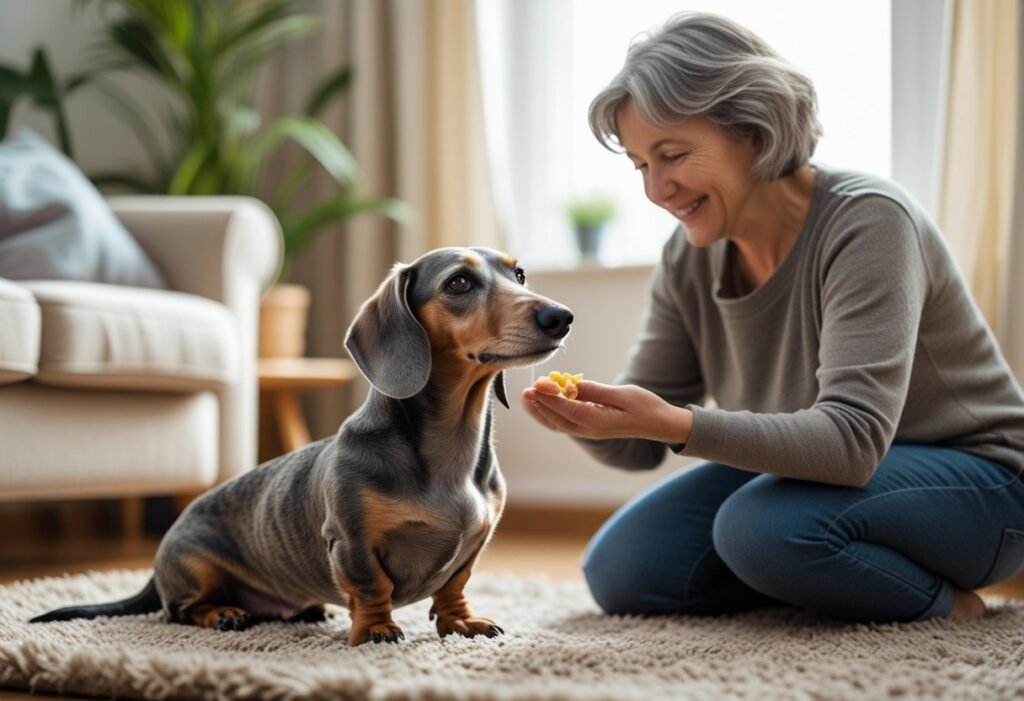
Overusing Punishment 🚫
Relying on punishment too much can make your dachshund anxious or less likely to listen 😟. Harsh corrections damage trust and can leave your dog feeling defensive 🛡️.
If your dog doesn’t get it right, take a breath—don’t yell or use physical punishment 😤. Focus on positive reinforcement like treats or praise when your dog does the right thing 🌟.
Mistakes are just part of learning ✏️. Gently redirect your dog to the right behavior and reward them when they get it 🍖.
Set clear rules, but lead with patience and encouragement 🐾. That’s what builds trust and makes your dachshund want to work with you 🤝.
Tailoring Training to Your Dachshund’s Unique Personality

Every dachshund has quirks and habits that make them unique 🌟. Figuring out what motivates your dog helps you build a training routine that actually works 🎯.
Recognizing Individual Motivators 🎾
Some dachshunds go wild for treats, while others light up over toys or praise 🍖. Watch your dog’s reactions during the day to spot what really gets their tail wagging 🐕🦺.
Try tracking motivators with a simple chart 📊:
| Reward Type | Interest Level | Signs of Engagement |
|---|---|---|
| Food Treats | High | Wags tail, stares, eager to work 🐾 |
| Toys | Medium | Picks up toy, playful 🎲 |
| Praise | Low | Looks at you, relaxed ears 😊 |
Test a few rewards to see what gets the best response 🔁. Rotate them if your dog seems bored—sometimes you’ve got to switch things up 🔄.
Motivators don’t always work the same way every day, so stay flexible 💡. That keeps your training fresh and effective ✅.

📹 Petcube Cam 360
- ✅ Observe your Dachshund’s reactions and training progress in real time 🎯
- ✅ Use voice interaction to reinforce calm behavior even while away 🗣️
- ✅ Helps identify triggers behind stubborn moments or anxiety 🧠
📍 Tractive DOG GPS Tracker
- ✅ Monitor your Dachshund’s activity and outdoor behavior safely 🌳
- ✅ Track runs or play sessions to measure progress and energy levels 💪
- ✅ Ensures safe, worry-free training sessions anywhere 🐾
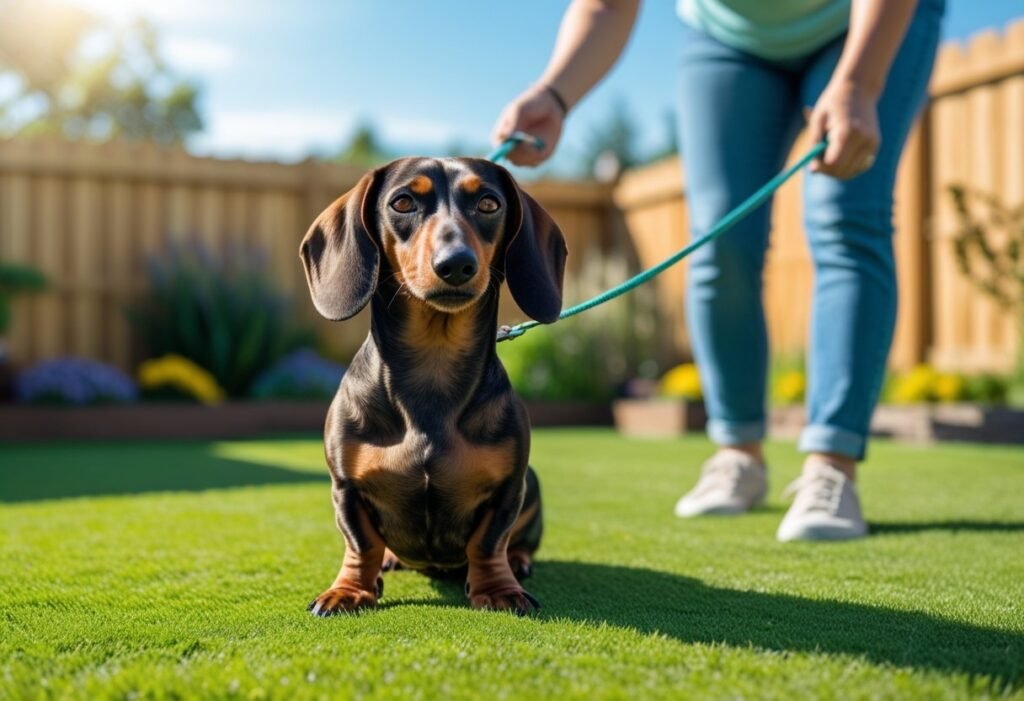
Adjusting Techniques for Better Results 🧩
Some dachshunds like step-by-step training 🪜. Others do better with short, playful bursts instead of long sessions 🎉.
If your dog starts yawning, lying down, or looking away, they’re probably losing focus 😴. Break tasks into tiny steps and celebrate every win with their favorite reward 🏅.
For easily distracted dogs, pick quiet spots with fewer interruptions 🌳. If a technique’s falling flat, don’t just repeat it—try a clicker or change up the time of day ⏰.
Little tweaks can make a big difference and help your dachshund learn in a way that feels fun, not frustrating 🐶.
Long-Term Success and Maintenance

Keeping your dachshund’s training on track takes steady routines and a bit of a proactive mindset 🧠. Regular check-ins and new challenges help keep things moving forward 🚀.
Ongoing Socialization and Enrichment 🌎
Keep introducing your dachshund to new people, places, and animals 🐾. Dogs need practice to stay comfortable in different situations 🐕.
Take walks in new parks, visit pet-friendly shops, or invite friends with calm dogs for a change of pace 🛍️. Mixing it up prevents boredom and keeps your dog curious 🧐.
Try enrichment activities like food puzzles or simple scent games 🎯. A little mental challenge goes a long way 🧩.
Rotate toys or change your walking route every so often 🔄. Teaching new tricks every few weeks also keeps your dachshund sharp 🎓.
Quick Ideas for Enrichment 💡
- Puzzle feeders 🧠
- Hiding treats 🔍
- Short training games 🎲
- Gentle tug-of-war 🤗
🌟 Training Tools & Routines That Reduce Stubbornness
- 💧 Petlibro Water Fountain — Proper hydration supports focus and calm during training sessions; multiple pets can drink without crowding, reducing tension and distraction.
- 🪜 Majestic Pet Stairs — Prevents jumping-related frustration and pain; easier movement means a more willing, comfortable learner during reward-based training.
- 🍪 Petcube Bites 2 — Deliver instant rewards remotely to reinforce good choices and break stubborn patterns; great for timed treats during recall and leave-it drills.
- 🛁 Pride + Groom Grooming Tools Kit — Gentle, patient grooming builds trust and cooperation — an easy, calming routine that boosts responsiveness during training.
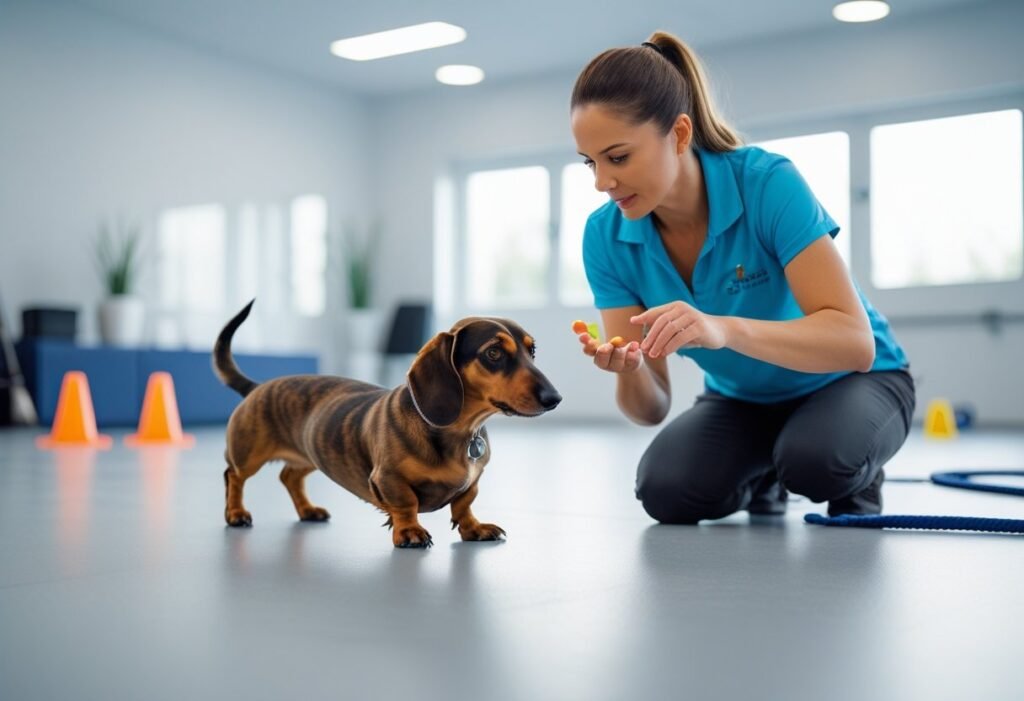
Monitoring Progress and Adjusting Strategies 📋
Check your dog’s progress by watching for changes in behavior 👀. Jot down notes or use a checklist—whatever works—to track things like how they respond to commands or handle new situations ✅.
If old problems crop up, tweak your approach 🔧. Maybe shorten training sessions, reward more often, or go back to easier skills for a bit ⏪.
- Shorten training if your dog zones out 💤
- Give more rewards when your dog listens 🍖
- Practice basics before harder stuff 🎓
Don’t be afraid to ask a trainer or vet for advice if you’re stuck 💬. Adjusting as your dog grows keeps your results strong 💪. Celebrate the small wins—progress isn’t always fast, and some habits take time to change 🌱.
When to Seek Professional Help

Sometimes, training at home just doesn’t cut it—especially with a stubborn dachshund 😤. Getting outside help can make a huge difference with tough behavior issues 🐾.
Working With a Certified Dog Trainer 🎓
Certified trainers have experience with those tricky behavior problems 🧠. Look for someone who uses positive reinforcement—not old-school harsh methods 🚫.
They’ll break training into small steps so your dachshund doesn’t get overwhelmed 🪜. Trainers can also spot things you might miss and give feedback that actually helps 📋.
If your dachshund isn’t responding, a professional might see the reason and offer a new plan 🔄. It’s worth asking for help before you get too frustrated 😩.
How to find a trainer 🔍
- Check their certification (CPDT-KA, IAABC, or similar) 📜
- Ask if they’ve worked with dachshunds or similar breeds 🐶
- Look up reviews or ask for references 🌟
- Make sure they use reward-based methods 🍖
💛 Confidence, Calm & Connection: Essentials for Easier Training 🎯
- 🦺 Embark Pet Adventure Harness – Provides balanced control during walks, reducing pulling and helping your Dachshund stay focused while learning leash manners 🐾
- 🌿 Innovet PurCBD Oil – Naturally eases anxiety and frustration that often fuel stubborn behavior, supporting calmer, more receptive training sessions 💧
- 🛁 King Klean Dog Shampoo (King Kanine) – A soothing, toxin-free shampoo that keeps your Dachshund relaxed during grooming — teaching patience and trust through calm care 🧼
- 👕 Dog is Good Apparel & Gifts – Stay motivated and positive through training with fun, inspiring designs that remind you both to enjoy the journey 💪
- 🎨 Purr & Mutt Personalized Dachshund Art – Celebrate milestones in your Dachshund’s progress with a personalized keepsake — a meaningful reminder of teamwork and growth 🌟
🐶 Stay patient, consistent, and kind — because training your Doxie’s heart is just as important as training their mind. 💛
Identifying When Specialized Support Is Needed 🛑
Serious behaviors like biting, strong fear, or anxiety may need a veterinary behaviorist or animal behavior specialist 🧑⚕️. If your dachshund shows aggression, freezes in new places, or acts out for no clear reason, get a professional assessment 👨⚕️.
Watch for these red flags 🚨
- Repeated growling, snapping, or biting 🐕
- Destructive habits that don’t improve with basic training 🪵
- Sudden changes in mood or routine ⚡
- Nonstop barking, pacing, or hiding 🐾
A veterinary behaviorist can check for medical issues, too 🩺. They might suggest medication, therapy, or a tailored training plan 🧾. Acting early can prevent things from getting worse and help your dachshund feel safe again 🛏️.
🐾 Don’t Miss Out!
Download our free Dachshund care guide to keep your furry friend happy and healthy.
Get Your Free Guide 🐶Frequently Asked Questions
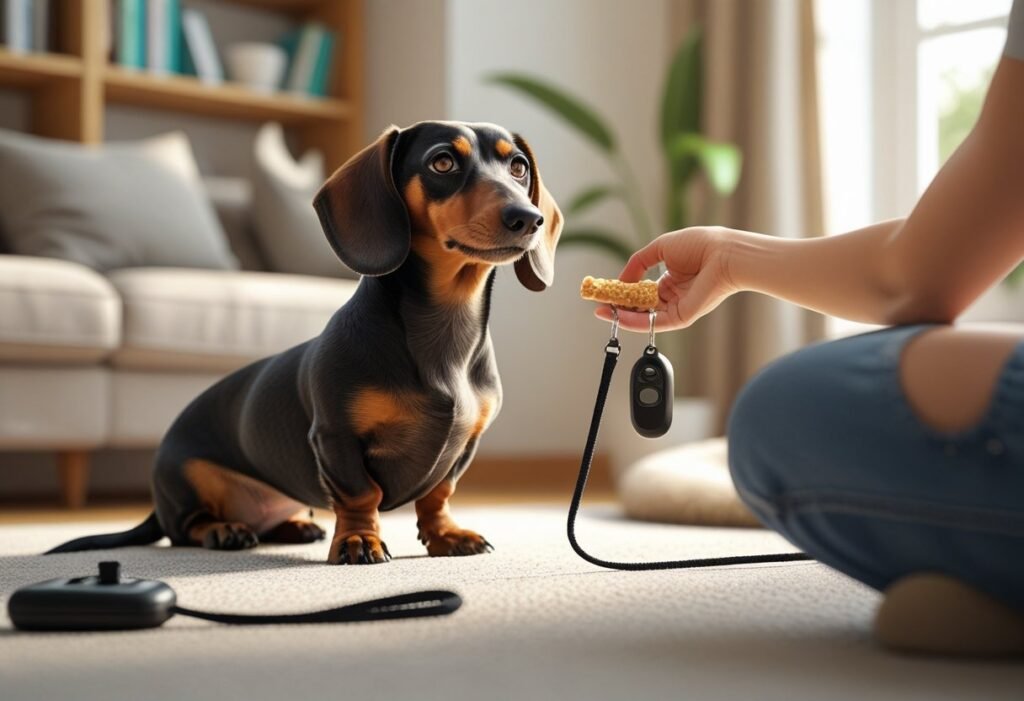
Dachshunds need patience and the right approach for training 🐾. Be gentle, use positive rewards, and stay consistent—this breed really responds to that 🌟.
What are effective techniques for potty training a Dachshund? 🚽
Stick to a regular schedule and take your dachshund outside after meals, naps, and play 🕒. Reward them right after they go potty outside so they connect the dots 🎉.
If there’s an accident, clean up with an odor remover and skip the scolding 🧼. Keep a close eye on them and use baby gates to limit mistakes indoors 🚫.
How can you teach a Dachshund to walk calmly on a leash? 🦮
Start out somewhere quiet, with fewer distractions 🌳. Use treats to encourage your dachshund to stay close by your side 🍖.
If your dog pulls, stop and wait until they come back to you ⏸️. Begin with short walks and slowly add more distractions as your dachshund gets better 🐾.
What methods help reduce excessive barking in Dachshunds? 🔊
Teach the “quiet” command and reward your dachshund when they stop barking 🧘. Try to figure out what’s setting them off and remove those triggers if you can 🚪.
Give your dachshund plenty of exercise and mental activities—boredom often leads to barking 🎾.
Why do Dachshunds exhibit disobedient behavior, and how can it be corrected? ❌
Dachshunds might act out if they’re bored, not exercised enough, or if rules aren’t clear 🧠. Set simple, consistent rules, and make sure everyone sticks to them 📋.
Keep training sessions short and positive to hold their attention ⏱️. Avoid harsh punishment—it just makes stubbornness worse 😟.
What are the best practices for preventing a Dachshund from snapping? ⚠️
Give your Dachshund some personal space, especially when they’re eating or playing with toys . Try not to surprise them with sudden touches or loud noises 🚫.
Show kids how to be gentle and calm when they’re around your dog 🧒. Start socializing your Dachshund early, and keep at it as they grow 🐶.
If you notice snapping, it’s probably time to reach out to a professional trainer 👩🏫. Sometimes a little expert help makes all the difference 🧠.
How can you provide appropriate mental stimulation for a Dachshund? 🧩
Puzzle toys and treat-dispensing balls can keep your Dachshund’s mind busy 🎁. Try teaching new tricks when you’ve got a few spare minutes 🎓.
Hide treats around the house and let your dog sniff them out—most Dachshunds love that game 🔍. Keep training sessions short, but do them daily for a little mental workout 🧠.
Swap out toys now and then so your Dachshund doesn’t lose interest 🔄. Honestly, they’ll let you know when they want something new 🐾.



